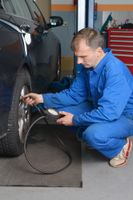A Quick Explanation of Winter's Effect on Tire Pressure

More than likely, you are already being greeted to a layer of frost on your car each morning. Cold weather will affect many areas of your vehicle, including its tire pressure. The guide from auto repair experts below will explain why you are more prone to seeing the tire pressure monitoring system (TPMS) sensors appear this time of year and what you should do about it.
How Does Cold Weather Affect Tires?
The air pressure inside your tires is affected by the temperature outside. When it’s cold out, the air molecules inside the tires contract, leading to underinflation. Auto repair specialists suggest checking your owner’s manual for the recommended tire pressure for your vehicle. For an accurate pressure reading, test the tires in the morning before the car has been driven or the sun has had a chance to warm them up.
 You can expect the tire pressure to drop one pound per square inch (PSI) for every 10-degree temperature drop. Check the air pressure at least once a month to offset these changes and keep the sensor light from appearing each time you get in your vehicle.
You can expect the tire pressure to drop one pound per square inch (PSI) for every 10-degree temperature drop. Check the air pressure at least once a month to offset these changes and keep the sensor light from appearing each time you get in your vehicle.
What Happens to Underinflated Tires?
If you choose to ignore the TPMS sensor, expect to suffer driving complications. Auto repair technicians state underinflated tires are known to cause lower gas economy and poor vehicle handling, which could produce steering wheel vibrations and make it difficult to brake on time.
Leaving your tires in this state for too long will also cause premature wear; most notably, the interior caves forward, putting more weight on the sidewall. This can lead to cracking and even a blowout. Underinflation also decreases the traction between the road and tires and creates a larger footprint, which can be incredibly dangerous on wet roads and lead to hydroplaning.
To avoid driving on underinflated tires, bring your vehicle to Stillwater Auto Clinic anytime the TPMS light appears. Since 1977, Steve Continenza and his auto repair team have provided trustworthy and dependable services to the East St. Paul/Maplewood, MN, regions. Whether you stop by for planned maintenance or unexpected repairs, expect quick work at competitive rates. For more information about this car repair shop, call them today at (651) 351-7188 and visit their website.
About the Business
Have a question? Ask the experts!
Send your question

